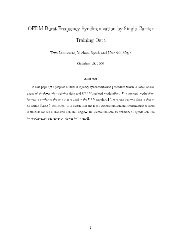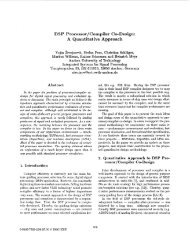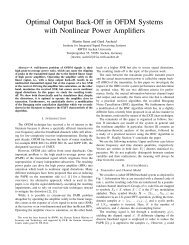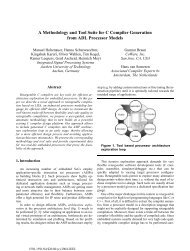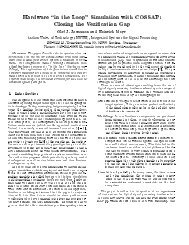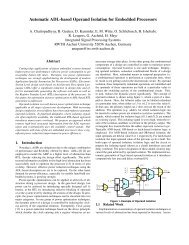Automatic Generation of JTAG Interface and Debug Mechanism - ICE
Automatic Generation of JTAG Interface and Debug Mechanism - ICE
Automatic Generation of JTAG Interface and Debug Mechanism - ICE
You also want an ePaper? Increase the reach of your titles
YUMPU automatically turns print PDFs into web optimized ePapers that Google loves.
4 describes the functionality <strong>of</strong> the generated <strong>JTAG</strong> interface<br />
<strong>and</strong> section 5 presents the functionality concerning the generated<br />
debug mechanism. The results are discussed in section 6.<br />
This paper ends with conclusion <strong>and</strong> future work.<br />
2 Related Work<br />
In this section, the related work concerning RTL synthesis<br />
from ADLs, architecture design systems, the debugging st<strong>and</strong>ard<br />
Nexus <strong>and</strong> the <strong>JTAG</strong> st<strong>and</strong>ard for a test access port are<br />
discussed.<br />
2.1 RTL Synthesis from ADLs<br />
Several ADLs support HDL-code generation from higher<br />
level <strong>of</strong> abstractions than RTL. So far, publications about an<br />
automatic generation <strong>of</strong> <strong>JTAG</strong> interface <strong>and</strong> debug mechanism<br />
from ADLs are not known.<br />
Some <strong>of</strong> the ADLs strongly oriented towards the<br />
instruction-set are ISDL [9] <strong>and</strong> nML [10]. For example, the<br />
synthesis tool HGEN [1] generates synthesizable Verilog code<br />
from an ISDL description. The HDL generator GO from Target<br />
Compilers Technologies [11], which is an industrial product,<br />
is based on the architecture description language nML.<br />
The project Sim-HS [3] is also based on the nML description<br />
language <strong>and</strong> generates synthesizable Verilog models from<br />
Sim-nML models.<br />
There are also approaches based on a combination <strong>of</strong> instruction<br />
set/architecture description. Some <strong>of</strong> them are the<br />
ADL EXPRESSION [12] [2], FlexWare [13] which is more<br />
related to RTL than the level <strong>of</strong> ADL, the PEAS-III [14] <strong>and</strong><br />
the derived ASIP-Meister [15] that work with a set <strong>of</strong> predefined<br />
components. Information on <strong>JTAG</strong> <strong>Interface</strong> <strong>and</strong> debug<br />
mechanism generation from any <strong>of</strong> these approaches is currently<br />
not available.<br />
2.2 Architecture Design Systems<br />
In addition to the work based on ADLs, architecture design<br />
systems have to be discussed here. The XTensa [16] environment<br />
from Tensilica [17] allows the user to select <strong>and</strong> configure<br />
predefined hardware elements. Hence, the design space<br />
exploration can be performed very efficiently <strong>and</strong> synthesis<br />
results are convincing. This approach is known to generate a<br />
<strong>JTAG</strong> interface <strong>and</strong> debug mechanism automatically. Detailed<br />
information about the performance is not publicly available.<br />
The S5000 family from Stretch [18] is based on the XTensa<br />
architecture <strong>and</strong> is enhanced with a flexible FPGA part, which<br />
is used to extend the instruction set. This design does contain<br />
a <strong>JTAG</strong> interface which makes the in-circuit debugging possible.<br />
The PICO (program in, chip out) [19] system developed<br />
by the HP-labs is based on a configurable architecture, including<br />
nonprogrammable accelerators <strong>and</strong> cache subsystems. Information<br />
about the generation <strong>of</strong> a debug mechanism is not<br />
known for the PICO system.<br />
2.3 The Nexus St<strong>and</strong>ard<br />
In 1999, the Nexus 5001 Forum released a st<strong>and</strong>ard for<br />
a global embedded processor debug interface called Nexus<br />
st<strong>and</strong>ard [20]. Nexus compliant debug interfaces are divided<br />
into four classes. The st<strong>and</strong>ard specifies features supported<br />
for each class. Class 1 compliant devices implement least<br />
<strong>and</strong> class 4 compliant devices implement most features. The<br />
st<strong>and</strong>ard also declares specifications about the download <strong>and</strong><br />
upload rate <strong>of</strong> the debug port <strong>and</strong> whether it is full- or halfduplex.<br />
Additionally, the Nexus st<strong>and</strong>ard defines an Application<br />
Programming <strong>Interface</strong> (API) for the debug mechanism.<br />
A complete list <strong>of</strong> the features required for a certain class can<br />
be found in [20].<br />
A processor with Nexus debug interface is capable <strong>of</strong><br />
switching to a special operation mode for debugging, when<br />
the processor core is halted. The current state <strong>of</strong> the processor<br />
core can be analyzed or modified via the debug mechanism.<br />
This operation mode is called debug mode. The usual operation<br />
mode is called user mode. The basic features required for<br />
making use <strong>of</strong> the debug mechanism are listed below.<br />
Entering debug mode <strong>and</strong> returning to user mode: The<br />
debug mode can be requested via an external pin. Also, debug<br />
mode is entered whenever a breakpoint interrupt occurs.<br />
Single step instruction in debug mode <strong>and</strong> re-enter debug<br />
mode: Sometimes it is very important to observe every<br />
step <strong>of</strong> execution <strong>of</strong> a critical part <strong>of</strong> an application. In this<br />
case, it is indispensable to run the instructions step by step.<br />
Register access in debug mode: The current state <strong>of</strong> the<br />
registers <strong>of</strong> the processor core (the so called user registers)<br />
have to be read in order to determine the current state <strong>of</strong> the<br />
processor. Writing to the user registers is useful to intervene<br />
during execution <strong>of</strong> a program <strong>and</strong> to force a special processor<br />
state.<br />
Memory access in debug mode: Similar to the state <strong>of</strong> the<br />
user registers, the content <strong>of</strong> the memory may be <strong>of</strong> interest<br />
during debugging. Therefore, it is useful to have read access<br />
to the memory in debug mode. Write access again gives the<br />
opportunity to manipulate the execution <strong>of</strong> a program.<br />
Hardware breakpoints: Similar to breakpoints in debuggers<br />
used for s<strong>of</strong>tware development, Nexus debug interfaces<br />
also support hardware breakpoints. If a breakpoint is hit, the<br />
processor switches to debug mode.<br />
For low rate half-duplex debug ports the Nexus st<strong>and</strong>ard<br />
makes use <strong>of</strong> the IEEE 1149.1 port, commonly known as<br />
<strong>JTAG</strong> port.<br />
2.4 The IEEE St<strong>and</strong>ard Test Access Port (<strong>JTAG</strong>)<br />
The IEEE st<strong>and</strong>ard 1149.1 ”St<strong>and</strong>ard Test Access Port<br />
<strong>and</strong> Boundary-Scan Architecture” was originally introduced<br />
in February 1990 by the Joint Test Action Group (<strong>JTAG</strong>).<br />
It has been modified several times up to its current version<br />
1149.1-2001 [21]. The st<strong>and</strong>ard defines a test access port <strong>and</strong><br />
a boundary-scan architecture for digital integrated circuits <strong>and</strong><br />
for the digital portions <strong>of</strong> mixed analog/digital integrated circuits.<br />
The acronym <strong>JTAG</strong> became synonymous with this st<strong>and</strong>ard<br />
over the years.




